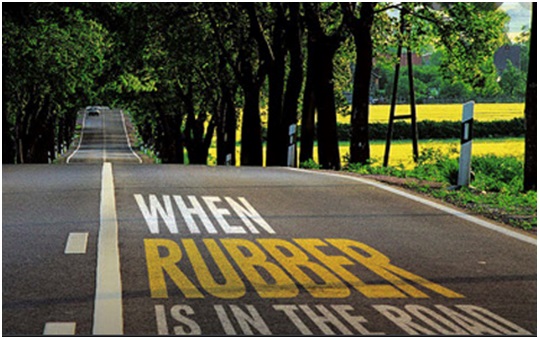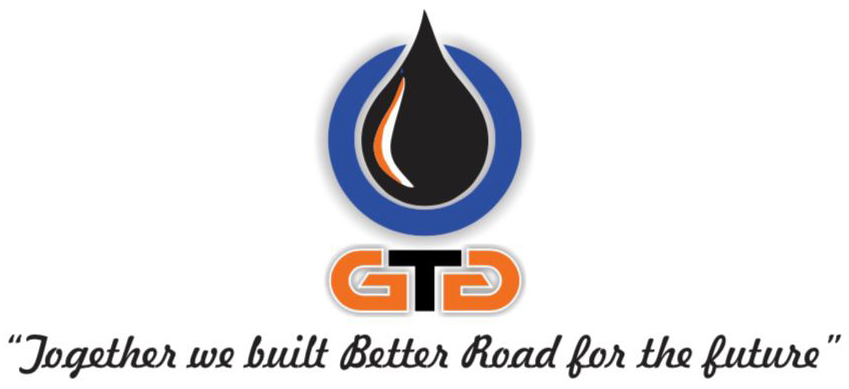CRMB
CRMB - Crumb Rubber Modified Bitumen
Crumb Rubber Modified Bitumen (CRMB) is hydrocarbon binder attained through the physical and chemical interaction of crumb rubber which is made by recycling of used tires with bitumen and some particular additives.
CRMB has been used the world over for the improvement of binder characteristics for use in wearing courses of flexible pavements.
CRMB modified bitumen prepared by the addition of reclaimed truck tires further improved by the additives.
Research worldwide has shown that the addition of crumb rubber to bitumen produces binders with improved resistance to combat pavement distresses such as rutting, fatigue cracking, thermal cracking etc. It has also been demonstrated that use of crumb rubber modified binder's leads to reducing of overlay thickness as well as reduce reflective cracking potential. This adequately demonstrates that CRMB is a superior binder which has immense application in highly trafficked National and State Highways of India.

Crumb Rubber can be used to added to the bituminous mixtures as a filler i.e. Dry Process, Through research has shown that bituminous mixtures produced in this way show limited engineering benefits as compared to the mixtures produces by addition of Crumb rubber to bitumen under appropriate processing conditions i.e. Wet Process.
Method used to modify asphalt with crumb rubber Modifier is the called "wet Method". The process requires cooking the liquid Bitumen and Crumb rubber Modifier at high temperatures(160 Deg C to 175 Deg C) for almost two and half hour. The time and temperature of digestion of Crumb rubber modifier with Bitumen are known to have an important effect on the resulting Crumb Rubber Modified Bitumen. The major effect is due to absorption by the rubber particles of aromatic oil in the Bitumen. This causes softening and swelling of rubber particles so that a comparatively large proportion of binder (CRMB) consists of soft rubber.
ENVIRONMENTAL AND ECONOMIC SIGNIFICANCE:
The most remarkable aspect of CRMB is the while producing a very superior engineering material, it also produces an environmentally friendly product. CRMB offers a solution to the waste disposal problem of the millions of tires produces the world over.
The addition of waste tires in place of costlier virgin polymers results in greater cost savings, lower energy consumption and lower environmental pollution. The highways made using CRMB have performed comparable with those produced using much costlier polymers.
ADVANTAGES OF CRMB
- Crumb Rubber Modified Bitumen Improves resistance to cracking resulting stronger and more durable overlays for corridors in the area of extreme climatic condition and heavy traffic loads.
- It reduces deformation on road, this specifically true at elevated temperature (50 to 70 Deg C), where rutting is excessive. It is achieved due to improve elastic recovery of Crumb Rubber based modified Bitumen, compared to conventional VG 30 or VG 10 Bitumen.
- Promote binder adhesion and cohesion to mineral aggregates. The striping level and reviling of aggregate from surface are reduced and offer resistant to creep deformation.
- Crumb rubber Modified Binder extend life of pavement by 50 % to 100%, when compared to conventional VG 30 - VG 10 or penetration grade 60/70 - 80/100 Bitumen.
Specifications of CRMB:
|
Characteristics |
Grade & Requirements |
|
|
|
|
CRMB 50 |
CRMB 55 |
CRMB 60 |
|
Penetration at 25℃, 0.1 mm, 100 g, 5 s. |
< 70 |
< 60 |
< 50 |
|
Softening point (R&B), ℃, Min |
50 |
55 |
60 |
|
Flash point, COC, ℃, Min |
220 |
220 |
220 |
|
Elastic recovery of half thread in ductilometer at 15 ℃, percent, Min |
50 |
50 |
50 |
|
Separation, difference in softening point (R&B), ℃, Max |
4 |
4 |
4 |
|
Viscosity at 150℃, Poise |
1-3 |
2-6 |
3-9 |
|
Thin film oven test and tests on residue: a) Loss in mass, percent, Max b) Increase in softening point, ℃, Max c) Reduction in penetration of residue,at 25℃, percent, Max d) Elastic recovery of half thread in ductilometer at 25 ℃, percent, Min |
1.0 7 40 35 |
1.0 6 40 35 |
1.0 5 40 35 |
